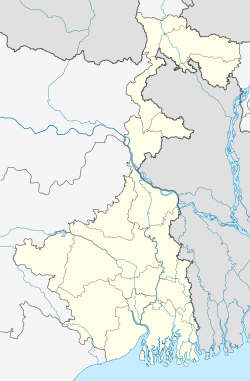- Dakshineswar
-
Dakhineswar — town — Coordinates 22°39′20″N 88°21′28″E / 22.6554310°N 88.3578620°ECoordinates: 22°39′20″N 88°21′28″E / 22.6554310°N 88.3578620°E Country India State West Bengal District(s) North 24 Parganas Time zone IST (UTC+05:30) Website north24parganas.nic.in - For the Kali temple, see Dakshineswar Kali Temple
Dakshineswar (Bengali: দক্ষিনেশ্বর) is a town in Barrackpore subdivision of North 24 Parganas district in West Bengal.
Contents
History
In 1847, Rani Rashmoni of Bengal began the construction of the famous Dakshineswar Kali Temple. Rani, who was a rich and pious widow of colonial Bengal had a divine revelation ordering her to construct a temple dedicated to goddess Kali. She started building the magnificent temple after this revelation. In spite of immense wealth she did not come from a very high caste being a Shudra. The Shudras, being the meanial class were not qualified to offer cooked rice to the deity as an offering. But rani out of her intense devotion didn't want her much loved Kali to go half starved by eating only fruits and uncooked rice. She called upon the Brahmins of greater Bengal to come and adjudicate on this problem. No Brahmin was liberal enough to break the unequal social evils and strictly forbade rani to offer cooked food to the goddess. Rani grew morose. At this time a learned scholar, Ramkumar Chattopadhay, who was the elder brother of Ramakrishna Paramahamsa came forward to Rani's rescue. He advised that if Rani donated the temple to a Brahmin, the Brahmin could then offer cooked rice on behalf of Rani. This would not break the traditional rules and yet help in fulfilling Rani's wish of offering cooked rice. This revolutionary suggestion created a storm in the social circles of Bengal in those days. The rani then proceeded to inaugurate the temple on an auspicious day.
Installation
Rani had the temple installed on the occasion of the Hindu festival of Snanyatra. It was a luxurious and flamboyant occasion. Brahmins invited for the installation came from as far as Kanauj, Chattagram, Orissa, and Navadwip. Each of them was gifted a silk garment and a gold coin. Thousands of people gathered to witness the spectacle. At the time, nine lakh rupees were spent by the Rani for this occasion.
Claim to fame
Dakshineswar became the workplace for Ramakrishna Paramahamsa, the famous 20th century saint of India, also regaurded as an incarnation of God on earth by many. For the upcoming years Dakshineswar would witness spectacular sadhana and unparalled asceticism by Ramakrishna. It would eventually draw numerous intellectual and aristocratic hindus from the nearby city of Calcutta which was the capital of British Empire at that time.
Ramakrishna formed around him a gathering of spiritual aspirants that condensed into later Ramakrishna Mission. His greatest disciple Vivekananda would proclaim the superiority of vedic culture over others which eventually gave rise to Bengali nationalism that intensely affected India as a whole.
Thus Dakshineswar could be counted as an important place of origin of the great socio religious renaissance of India.
There is also another famous temple in Dakshineswar - the Adyapeeth[1]
On the West bank of Hoogli River (almost across Dakshineswar), is Belur Math, the headquarters of the Ramakrishna Mission, an association founded by Swami Vivekananda in 1897.
Before the temple was built, the nawabs of Chitpur used to hunt tigers at Dakshineswar.[2]
Geography
Dakshineshwar is located at 22°39′20″N 88°21′28″E / 22.6554310°N 88.3578620°E.
It is situated alongside the Vivekananda Setu, in the North 24 Parganas district, north of Calcutta, on the East bank of Hoogli River, is famous for its temples. Dakshineswar is 14 km from Sealdah on the Sealdah-Dankuni section of Eastern Railway[3]
Healthcare
North 24 Parganas district has been identified as one of the areas where ground water is affected by arsenic contamination.[4]
References
- ^ Adyapeeth.
- ^ Cotton, H.E.A., Calcutta Old and New, 1909/1980, p807, General Printers and Publishers Pvt. Ltd.
- ^ Eastern Railway time table.
- ^ "Groundwater Arsenic contamination in West Bengal-India (19 years study )". Groundwater arsenic contamination status of North 24-Parganas district, one of the nine arsenic affected districts of West Bengal-India. SOES. http://www.soesju.org/arsenic/wb2.htm. Retrieved 2007-08-24.
External links
Dakshineswar travel guide from Wikitravel
Neighbourhoods in Kolkata KMC - Alipore
- B.B.D. Bagh
- Bagbazar
- Baghajatin
- Ballygunge
- Bansdroni
- Barisha
- Behala
- Belgachia
- Bhowanipore
- Bowbazar
- Bow Barracks
- Brahmapur
- Burrabazar
- Chak Garia
- China Town
- Chitpur
- Chowringhee
- Cossipore
- Dhakuria
- Dharamtala
- Entally
- Esplanade
- Garden Reach
- Garia
- Golf Green
- Haltu
- Haridevpur
- Jadavpur
- Janbazar
- Jodhpur Park
- Jorabagan
- Jorasanko
- Kalighat
- Kasba
- Kidderpore
- Kudghat
- Kumortuli
- Lake Gardens
- Lalbazar
- Lansdowne
- Maniktala
- Metiabruz
- Naktala
- New Alipore
- New Garia
- Park Circus
- Parnasree Pally
- Pathuriaghata
- Picnic Garden
- Posta
- Rajabazar
- Sahapur
- Santoshpur
- Sarsuna
- Shyambazar
- Shyampukur
- Shobhabazar
- Sonagachi
- Taltala
- Tangra
- Thakurpukur
- Tollygunge
- Ultadanga
KMDA - Baguiati
- Baidyabati
- Bally
- Bansberia
- Baranagar
- Barrackpore
- Barasat
- Batanagar
- Belur
- Bhadreswar
- Budge Budge
- Chandannagar
- Dakshineswar
- Dankuni
- Dum Dum
- Durganagar
- Garulia
- Halisahar
- Howrah
- Hugli-Chuchura
- Jaynagar Mazilpur
- Joka
- Kalyani
- Kamarhati
- Kanchrapara
- Kestopur
- Khardaha
- Konnagar
- Madhyamgram
- Narendrapur
- New Barrackpur
- North Barrackpur
- North Dumdum
- Nungi
- Panihati
- Pujali
- Rajarhat (New Town)
- Rishra
- Salt Lake
- Serampore
- Sodepur
- Sonarpur
- South Dumdum
- Titagarh
- Uluberia
- Uttarpara
- Streets of Kolkata
- Kolkata topics
- West Bengal portal
Categories:- Neighbourhoods in Kolkata
- Cities and towns in North 24 Parganas district
Wikimedia Foundation. 2010.



